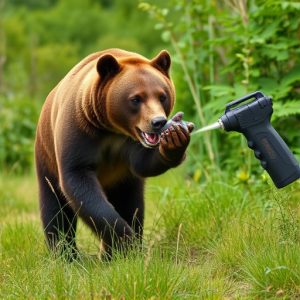Bear Spray: Effective Wilderness Defense – Range, Use, & Legalities
Bear spray is an effective self-defense tool for outdoor enthusiasts in bear country, but its perfor…….
Bear spray is an effective self-defense tool for outdoor enthusiasts in bear country, but its performance varies based on factors like distance, wind conditions, and terrain. The optimal range for bear spray use is 20-30 feet (6-9 meters), where aiming at the bear's face and eyes ensures maximum impact. Proper technique, high-quality equipment with adjustable nozzles, larger canisters, and higher capsaicin concentrations enhance its effectiveness. Understanding local regulations and best practices, including complementary wilderness safety measures, is crucial for responsible use of bear spray in areas inhabited by bears.
“Bear spray, a powerful wilderness protection device, offers an essential tool for adventurers navigating risky terrain. This article delves into the mechanics of bear spray, exploring how it works and its inherent limitations. We analyze key factors influencing its range and effectiveness, providing best practices for optimal use in the wild. Additionally, we dissect legal considerations and regulations surrounding carrying bear spray, with a focus on understanding the ideal distance for maximizing its protective benefits. Get equipped to tackle potential encounters with confidence.”
- Understanding Bear Spray: How It Works and Its Limitations
- Factors Influencing Bear Spray Range and Effectiveness
- Best Practices for Using Bear Spray in the Wilderness
- Legal Considerations and Regulations for Carrying Bear Spray
Understanding Bear Spray: How It Works and Its Limitations
Bear spray, also known as bear repellent, is a popular self-defense tool for outdoor enthusiasts and individuals navigating wilderness areas prone to bear encounters. It’s designed to create a barrier between the user and the bear by releasing a potent mixture of capsicum (a type of chili pepper) and other chemicals when sprayed. This irritates the bear’s eyes, nose, and throat, temporarily disorienting it and encouraging the bear to retreat.
While bear spray is an effective deterrent in many situations, understanding its limitations is crucial for safe wilderness protection. The optimal range for bear spray effectiveness varies based on several factors, including the size of the bear, wind conditions, and terrain. Generally, experts recommend aiming for a best distance of 25-30 feet (7.6-9 meters) to ensure maximum impact. Beyond this range, the spray may not reach the bear effectively enough to deter an aggressive or defensive encounter. However, it’s important to note that even within this optimal range, conditions can affect performance; strong winds, for instance, can blow the spray away from its target.
Factors Influencing Bear Spray Range and Effectiveness
The effectiveness of bear spray is influenced by several factors, with the best distance for optimal impact being a key consideration. Wind direction and speed play a significant role; spraying into the wind increases the range and ensures the pepper spray reaches the bear’s eyes and nasal passages, triggering a temporary disorientation and reduced aggression. On calm days, the spray can be effective up to 30 feet (9 meters) away, allowing users time to retreat or deter an approaching bear.
Other variables include the type of sprayer, canister size, and concentration of capsaicin, the active ingredient. High-quality bear sprayers with adjustable nozzles offer better control over the spray pattern and distribution. Larger canisters provide a longer reach, while higher concentrations of capsaicin ensure stronger irritation. Proper technique is also crucial; aiming for the face and eyes of the bear maximises its effectiveness, making it an essential tool for wilderness protection and ensuring safety during outdoor adventures in bear country.
Best Practices for Using Bear Spray in the Wilderness
When using bear spray in the wilderness, understanding the best practices is crucial for its effectiveness. One of the key factors to remember is the optimal distance for application. It’s recommended to keep a safe distance of 20-30 feet (approximately 6-9 meters) from the approaching bear. At this range, the spray can cover the bear’s face and eyes, causing temporary disorientation and reduced aggression.
Ensure that you aim high, targeting the bear’s face and neck area. The goal is to create a barrier of pepper spray between you and the animal, allowing you to retreat or de-escalate the situation. It’s important to remember that bear spray is not a substitute for good wilderness practices; always make noise while hiking in bear country, travel in groups, and store food securely to minimize potential encounters.
Legal Considerations and Regulations for Carrying Bear Spray
In many regions, carrying bear spray is regulated to ensure public safety and wildlife conservation. Before heading into the wilderness, it’s crucial to understand the legal considerations and regulations surrounding bear spray possession and use. Each jurisdiction has its own set of rules, so checking with local authorities is essential. In general, you may need a permit or registration for certain types and quantities of bear spray, and there might be restrictions on where and how it can be carried.
Knowing the best distance for bear spray effectiveness is also vital. Bear sprays are designed to deter bears at close range, typically from 20 to 30 feet (6 to 9 meters). Beyond this range, the spray may not reach the bear’s eyes and nose effectively, reducing its deterrent effect. Always carry bear spray in an easily accessible location, such as on a belt or in a backpack, ensuring you can deploy it quickly if needed.
Bear spray is a valuable tool for wilderness safety, but understanding its range and limitations is crucial. The best distance for bear spray effectiveness varies based on factors like wind, terrain, and bear behavior. Following best practices ensures its potency when needed most. Staying informed about local regulations and using it responsibly can significantly enhance your safety in bear country. Remember, knowledge and preparedness are key to navigating potential encounters peacefully.


